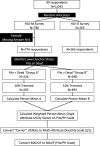Development of a multiplicative, multi-attribute utility function and eight single-attribute utility functions for the Health Utilities Index Mark 3 in Japan
- PMID: 32246218
- PMCID: PMC7125285
- DOI: 10.1186/s41687-020-00188-8
Development of a multiplicative, multi-attribute utility function and eight single-attribute utility functions for the Health Utilities Index Mark 3 in Japan
Abstract
Background: The Health Utilities Index Mark 3 (HUI3) is a generic multi-attribute, preference-based system for assessing health-related quality of life. It is widely used overseas as an outcome measure and for estimating quality-adjusted life years. We aimed to estimate a multi-attribute and eight single-attribute utility functions for the HUI3 system based on community preferences in Japan. We conducted two preference surveys in this study. The first survey was designed to estimate a model of utility function and collect preference scores, and the second survey was designed to evaluate predictive validity of the utility function and provide independent scores. Values obtained from the feeling thermometer and standard gamble scores obtained from using a chance board were included in the preference scale. We recruited 1043 respondents (age: 20-79 years) from five cities in Japan through the general population classified by sex and age groups. Respondents were further randomly divided into a modeling group (n = 774) and a direct group (n = 263).
Results: We acquired the estimation for eight single-attribute and a global multi-attribute utility function. The minimum expected multi-attribute utility score was - 0.002. The intraclass correlation coefficient between the directly measured utility score and the score generated by multi-attribute function in terms of 53 health conditions was 0.742.
Conclusions: The HUI3 scoring function developed in Japan has a strong theoretical and empirical basis. It will be useful in future to predict the directly measured score of health technology assessments in Japan.
Keywords: Health utilities index; Health utilities index mark 3; Health-related quality of life; Preference-based measure; Quality-adjusted life year; Standard gamble.
Conflict of interest statement
The authors declare that they have no competing interests.
Figures
References
-
- National Institute for Health and Care Excellence . Guide to the methods of technology appraisal. London: National Institute for Health and Care Excellence; 2013. - PubMed
-
- Canadian Agency for Drugs and Technologies in Health . Guidelines for the economic evaluation of health technologies. 3. Ottawa: Canadian Agency for Drugs and Technologies in Health; 2006.
-
- Haute Autorité de Santé . Choices in methods for economic evaluation. Paris: Haute Autorité de Santé; 2002.
Grants and funding
LinkOut - more resources
Full Text Sources



